A Review on Global Cooperation Network in the Interdisciplinary Research of Geochemistry Combined with Artificial Intelligence
Abstract
:1. Introduction
2. Data and Methods
2.1. Data Resources
2.2. Methods
3. Analysis of Research Network Cooperation
3.1. Parameter Settings
3.1.1. G-Index
3.1.2. Top N and Top N%
3.1.3. Centrality
3.1.4. Pruning
3.2. Analysis of Publications
3.3. Cooperative Network of Countries/Regions
3.4. Cooperative Network of Research Institution
4. Discussion of Research Hotspots
4.1. Keywords Clustering
4.2. Keyword Timeline
- In the initial phase of GC-AI, researchers concentrated on utilizing rule-based techniques to recognize and categorize patterns and characteristics in geochemical data applications, including Bayesian networks and decision trees, among others. The field of geochemical artificial intelligence started to shift from rule-based methods to machine learning with the emergence of artificial intelligence (AI) technologies. Machine learning techniques enable automatic learning of data features and patterns without the need for manual feature design and selection, thus saving time. Some examples of these techniques include random forest, artificial neural networks, deep neural networks (i.e., deep learning), and others.
- In recent years, the study and implementation of geochemical artificial intelligence have broadened to encompass various domains. These involve deploying machine learning algorithms for ore formation prophecy, the automated detection and prediction of groundwater contamination, the quantitative examination of rare earth elements’ distribution patterns, climate change forecasting and prevention, and more. Currently, the application domain is expanding continuously, and investigations on the deep Earth, deep space, and deep sea are the primary focus of upcoming research.
4.3. Keyword Brust Analysis
4.4. Discussion
5. Conclusions and Prospect
- Research trend: Based on the analysis of publications in the literature, it was observed that the research in this field witnessed a gradual increase before 2017, followed by a notable surge in the number of publications thereafter, with a steep annual rise. By 2022, the volume of publications had surged to 3.7 times that of 2013, highlighting the increasing significance of artificial intelligence techniques in the research toolbox of geochemists. The study of artificial intelligence techniques for geochemistry is quickly progressing within the GC-AI field.
- Characteristics of cooperative network: A network analysis was conducted on the national/regional and institutional cooperative network to uncover research collaboration patterns in this area. The results indicate a high research standard and internationalization level. The cooperative network has the characteristics of being close-knit and diverse. Research institutions from China, the United States, and Europe are prominent in this field, with many cooperative relationships and research outcomes. Notably, the National Aeronautics and Space Administration and Université libre de Bruxelles exhibit a high level of research and impact.
- Research hotspots: Through analysis of keyword co-occurrence networks and clustering, timeline, and burst word detection, it was found that some clusters have high relevance and similarity in the field of geochemical artificial intelligence. The application of artificial intelligence technology for mineral resource prediction is currently a research hotspot, and deep space, deep Earth, and deep sea mineral resource exploration will become future research trends.
Author Contributions
Funding
Data Availability Statement
Acknowledgments
Conflicts of Interest
References
- Tolle, K.M.; Tansley, D.S.W.; Hey, A.J.G. The fourth paradigm: Data-intensive scientific discovery. Proc. IEEE 2011, 99, 1334–1337. [Google Scholar] [CrossRef]
- Zhou, Y.; Zuo, R.; Liu, G.; Yuan, F.; Mao, X.; Guo, Y.; Xiao, F.; Liao, J.; Liu, Y. The great-leap-forward development of mathematical geoscience during 2010–2019: Big data and artificial intelligence algorithm are changing mathematical geoscience. Bull. Miner. Pet. Geochem. 2021, 40, 556–573. [Google Scholar] [CrossRef]
- Zhang, W.G.; Ching, J.Y.; Goh, A.T.C.; Leung, A.Y.F. Big data and machine learning in geoscience and geoengineering: Introduction. Geosci. Front. 2020, 12, 327–329. [Google Scholar] [CrossRef]
- Zhang, W.; Gu, X.; Tang, L.; Yin, Y.; Liu, D.; Zhang, Y. Application of machine learning, deep learning and optimization algorithms in geoengineering and geoscience: Comprehensive review and future challenge. Gondwana Res. 2022, 109, 1–17. [Google Scholar] [CrossRef]
- Petrelli, M.; Bizzarri, R.; Morgavi, D.; Baldanza, A.; Perugini, D. Combining machine learning techniques, microanalyses and large geochemical datasets for tephrochronological studies in complex volcanic areas: New age constraints for the Pleistocene magmatism of central Italy. Quat. Geochronol. 2017, 40, 33–44. [Google Scholar] [CrossRef]
- Jiao, S.; Zhang, Q.; Zhou, Y.; Chen, W.; Liu, X. Gopalakrishnan. Progress and challenges of big data research on petrology and geochemistry. Solid Earth Sci. 2018, 3, 105–114. [Google Scholar] [CrossRef]
- Han, S.; Li, M.; Zhang, Q.; Song, L. An Automated Method to Generate and Evaluate Geochemical Tectonic Discrimination Diagrams Based on Topological Theory. Minerals 2020, 10, 62. [Google Scholar] [CrossRef]
- Liu, X.; Zhang, Q.; Zhang, C. Identification of the Original Tectonic Setting for Oceanic Andesite Using Discrimination Diagrams: An Approach Based on Global Geochemical Data Synthesis. J. Earth Sci. 2022, 33, 696–705. [Google Scholar] [CrossRef]
- O’Sullivan, G.; Chew, D.; Kenny, G.; Henrichs, I.; Mulligan, D. The trace element composition of apatite and its application to detrital provenance studies. Earth Sci. Rev. 2020, 201, 103044. [Google Scholar] [CrossRef]
- Saha, R.; Upadhyay, D.; Mishra, B. Discriminating tectonic setting of igneous rocks using biotite major element chemistry—A machine learning approach. Geochem. Geophys. Geosyst. 2021, 22, e2021GC010053. [Google Scholar] [CrossRef]
- Zheng, D.; Wu, S.; Ma, C.; Xiang, L.; Hou, L.; Chen, A.; Hou, M. Zircon classification from cathodoluminescence images using deep learning. Geosci. Front. 2022, 13, 101436. [Google Scholar] [CrossRef]
- Wang, C.-L.; Zhu, W.-N.; Wang, Y.-T. Genesis of the Kiruna-type Nixintage iron deposit, Chinese Western Tianshan, NW China: Constrains of ore geology, geochemistry and geochronology. J. Geochem. Explor. 2022, 243, 107094. [Google Scholar] [CrossRef]
- Chen, N.; Mao, J.; Zhang, Z.; Duan, Z.; Santos, A.; Li, H. Arc magmatic evolution and porphyry copper deposit formation under compressional regime: A geochemical perspective from the Toquepala arc in Southern Peru. Earth-Sci. Rev. 2023, 240, 104383. [Google Scholar] [CrossRef]
- Zhang, P.; Zhang, Z.; Yang, J.; Cheng, Q. Machine Learning Prediction of Ore Deposit Genetic Type Using Magnetite Geochemistry. Nat. Resour. Res. 2023, 32, 99–116. [Google Scholar] [CrossRef]
- Zuo, R.; Xiong, Y. Big data analytics of identifying geochemical anomalies supported by machine learning methods. Nat. Resour. Res. 2018, 27, 5–13. [Google Scholar] [CrossRef]
- Chen, Y.; Zhao, Q. Mineral exploration targeting by combination of recursive indicator elimination with the ℓ2-regularization logistic regression based on geochemical data. Ore Geol. Rev. 2021, 135, 104213. [Google Scholar] [CrossRef]
- Hawkes, H.E.; Webb, J.S. Geochemistry in Mineral Exploration; Harper and Row: New York, NY, USA, 1962. [Google Scholar]
- Sinclair, A.J. Selection of threshold values in geochemical data using probability graphs. J. Geochem. Explor. 1974, 3, 129–149. [Google Scholar] [CrossRef]
- Tukey, J.W. Exploratory Data Analysis; Addison-Wesley: Reading, PA, USA, 1977. [Google Scholar]
- Reimann, C.; Filzmoser, P.; Garrett, R.; Dutter, R. Statistical Data Analysis Explained: Applied Environmental Statistics with R; John Wiley & Sons: Hoboken, NJ, USA, 2008. [Google Scholar]
- Matheron, G. Traité de Géostatistique Appliquée; Editions Technip: Paris, France, 1962. [Google Scholar]
- Cheng, Q.; Agterberg, F.P.; Ballantyne, S.B. The separation of geochemical anomalies from background by fractal methods. J. Geochem. Explor. 1994, 51, 109–130. [Google Scholar] [CrossRef]
- Cheng, Q.; Xu, Y.; Grunsky, E. Integrated spatial and spectrum method for geochemical anomaly separation. Nat. Resour. Res. 2000, 9, 43–52. [Google Scholar] [CrossRef]
- Cheng, Q. Mapping singularities with stream sediment geochemical data for prediction of undiscovered mineral deposits in Gejiu, Yunnan Province, China. Ore Geol. Rev. 2007, 32, 314–324. [Google Scholar] [CrossRef]
- Gonbadi, A.M.; Tabatabaei, S.H.; Carranza, E.J.M. Supervised geochemical anomaly detection by pattern recognition. J. Geochem. Explor. 2015, 157, 81–91. [Google Scholar] [CrossRef]
- Parsa, M.; Maghsoudi, A. Assessing the effects of mineral systems-derived exploration targeting criteria for random Forests-based predictive mapping of mineral prospectivity in Ahar-Arasbaran area, Iran. Ore Geol. Rev. 2021, 138, 104399. [Google Scholar] [CrossRef]
- Zuo, R.; Carranza, E.J.M. Support vector machine: A tool for mapping mineral prospectivity. Comput. Geosci. 2011, 37, 1967–1975. [Google Scholar] [CrossRef]
- Maepa, F.; Smith, R.S.; Tessema, A. Support vector machine and artificial neural network modelling of orogenic gold prospectivity mapping in the Swayze greenstone belt, Ontario, Canada. Ore Geol. Rev. 2020, 130, 103968. [Google Scholar] [CrossRef]
- Chen, Y.; Wu, W. Mapping mineral prospectivity by using one-class support vector machine to identify multivariate geological anomalies from digital geological survey data. Aust. J. Earth Sci. 2017, 64, 639–651. [Google Scholar] [CrossRef]
- Chen, Y.; Wu, W.; Zhao, Q. A bat-optimized one-class support vector machine for mineral prospectivity mapping. Minerals 2019, 9, 317. [Google Scholar] [CrossRef]
- Xiong, Y.; Zuo, R. A positive and unlabeled learning algorithm for mineral prospectivity mapping. Comput. Geosci. 2020, 147, 104667. [Google Scholar] [CrossRef]
- Ziaii, M.; Pouyan, A.A.; Ziaei, M. Neuro-fuzzy modelling in mining geochemistry: Identification of geochemical anomalies. J. Geochem. Explor. 2009, 100, 25–36. [Google Scholar] [CrossRef]
- Yu, X.; Xiao, F.; Zhou, Y.; Wang, Y.; Wang, K. Application of hierarchical clustering, singularity mapping, and Kohonen neural network to identify Ag-Au-Pb-Zn polymetallic mineralization associated geochemical anomaly in Pangxidong district. J. Geochem. Explor. 2019, 203, 87–95. [Google Scholar] [CrossRef]
- Wang, Z.; Dong, Y.; Zuo, R. Mapping geochemical anomalies related to Fe–polymetallic mineralization using the maximum margin metric learning method. Ore Geol. Rev. 2019, 107, 258–265. [Google Scholar] [CrossRef]
- Xiong, Y.; Zuo, R. Recognition of geochemical anomalies using a deep autoencoder network. Comput. Geosci. 2016, 86, 75–82. [Google Scholar] [CrossRef]
- Luo, Z.; Xiong, Y.; Zuo, R. Recognition of geochemical anomalies using a deep variational autoencoder network. Appl. Geochem. 2020, 122, 104710. [Google Scholar] [CrossRef]
- Luo, Z.; Zuo, R.; Xiong, Y.; Wang, X. Detection of geochemical anomalies related to mineralization using the GANomaly network. Appl. Geochem. 2021, 131, 105043. [Google Scholar] [CrossRef]
- Yang, N.; Zhang, Z.; Yang, J.; Hong, Z.; Shi, J. A convolutional neural network of GoogLeNet applied in mineral prospectivity prediction based on multi-source geoinformation. Nat. Resour. Res. 2021, 30, 3905–3923. [Google Scholar] [CrossRef]
- Yang, N.; Zhang, Z.; Yang, J.; Hong, Z. Mineral Prospectivity Prediction by Integration of Convolutional Autoencoder Network and Random Forest. Nat. Resour. Res. 2022, 31, 1103–1119. [Google Scholar] [CrossRef]
- Wang, Z.; Zuo, R. Mineral prospectivity mapping using a joint singularity-based weighting method and long short-term memory network. Comput. Geosci. 2022, 158, 104974. [Google Scholar] [CrossRef]
- Li, T.; Zuo, R.; Zhao, X.; Zhao, K. Mapping prospectivity for regolith-hosted REE deposits via convolutional neural network with generative adversarial network augmented data. Ore Geol. Rev. 2022, 142, 104693. [Google Scholar] [CrossRef]
- Lyons, K.J.; Ikonen, J.; Hokajärvi, A.-M.; Räsänen, T.; Pitkänen, T.; Kauppinen, A.; Kujala, K.; Rossi, P.M.; Miettinen, I.T. Monitoring Groundwater Quality with Real-Time Data, Stable Water Isotopes, and Microbial Community Analysis: A Comparison with Conventional Methods. Sci. Total. Environ. 2023, 864, 161199. [Google Scholar] [CrossRef]
- Huang, J.; Wang, D.; Zhu, Y.; Yang, Z.; Yao, M.; Shi, X.; An, T.; Zhang, Q.; Huang, C.; Bi, X.; et al. An overview for monitoring and prediction of pathogenic microorganisms in the atmosphere. Fundam. Res. 2023. [Google Scholar] [CrossRef]
- Siddiqi, S.A.; Al-Mulla, Y. Wireless Sensor Network System for Precision Irrigation using Soil and Plant Based Near-Real Time Monitoring Sensors. Procedia Comput. Sci. 2022, 203, 407–412. [Google Scholar] [CrossRef]
- Zuo, R.; Wang, J.; Xiong, Y.; Wang, Z. The processing methods of geochemical exploration data: Past, present, and future. Appl. Geochem. 2021, 132, 105072. [Google Scholar] [CrossRef]
- Parsa, M.; Sadeghi, M.; Grunsky, E. Innovative methods applied to processing and interpreting geochemical data. J. Geochem. Explor. 2022, 237, 106983. [Google Scholar] [CrossRef]
- Gelencsér, O.; Árvai, C.; Mika, L.; Breitner, D.; LeClair, D.; Szabó, C.; Falus, G.; Szabó-Krausz, Z. Effect of hydrogen on calcite reactivity in sandstone reservoirs: Experimental results compared to geochemical modeling predictions. J. Energy Storage 2023, 61, 106737. [Google Scholar] [CrossRef]
- Wang, J.; Zhou, Y.; Xiao, F. Identification of multi-element geochemical anomalies using unsupervised machine learning algorithms: A case study from Ag–Pb–Zn deposits in north-western Zhejiang, China. Appl. Geochem. 2020, 120, 104679. [Google Scholar] [CrossRef]
- Zhang, S.; Bourdeau, J.; Nwaila, G.; Ghorbani, Y. Advanced geochemical exploration knowledge using machine learning: Prediction of unknown elemental concentrations and operational prioritization of re-analysis campaigns. Artif. Intell. Geosci. 2022, 3, 86–100. [Google Scholar] [CrossRef]
- Zuo, R.; Wang, J.; Yin, B. Visualization and interpretation of geochemical exploration data using GIS and machine learning methods. Appl. Geochem. 2021, 134, 105111. [Google Scholar] [CrossRef]
- Zuo, R.; Xiong, Y.; Wang, J.; Carranza, E.J.M. Deep learning and its application in geochemical mapping. Earth-Science Rev. 2019, 192, 1–14. [Google Scholar] [CrossRef]
- Mkono, C.N.; Chuanbo, S.; Mulashani, A.K.; Mwakipunda, G.C. Deep learning integrated approach for hydrocarbon source rock evaluation and geochemical indicators prediction in the Jurassic–Paleogene of the Mandawa basin, SE Tanzania. Energy 2023, 2023, 129232. [Google Scholar] [CrossRef]
- Chen, C. CiteSpace II: Detecting and visualizing emerging trends and transient patterns in scientific literature. J. Am. Soc. Inf. Sci. Technol. 2006, 57, 359–377. [Google Scholar] [CrossRef]
- Chen, C.; Ibekwe-SanJuan, F.; Hou, J. The structure and dynamics of co-citation clusters: A multiple-perspective co-citation analysis. J. Am. Soc. Inf. Sci. Technol. 2010, 61, 1386–1409. [Google Scholar] [CrossRef]
- Dan, Z.; Jiapeng, X.; Yizhu, Z. Study on sustainable urbanization literature based on Web of Science, scopus, and China national knowledge infrastructure: A scientometric analysis in CiteSpace. J. Clean. Prod. 2020, 264, 121537. [Google Scholar]
- Zuo, Z.; Cheng, J.; Guo, H.; Li, Y. Knowledge mapping of research on strategic mineral resource security: A visual analysis using CiteSpace. Resour. Policy 2021, 74, 102372. [Google Scholar] [CrossRef]
- Yu, S.; Deng, H.; Liu, Z.; Chen, J.; Gu, X.; Li, J.; Xiao, K.; Mao, X. Identifying multivariate geochemical anomalies via tensor dictionary learning over spatial-elemental dimensionalities. Comput. Geosci. 2022, 165, 105153. [Google Scholar] [CrossRef]
- Doucet, L.S.; Tetley, M.G.; Li, Z.-X.; Liu, Y.; Gamaleldien, H. Geochemical fingerprinting of continental and oceanic basalts: A machine learning approach. Earth-Science Rev. 2022, 233, 104192. [Google Scholar] [CrossRef]
- Salgado, L.; López-Sánchez, C.; Colina, A.; Baragaño, D.; Forján, R.; Gallego, J. Hg and As pollution in the soil-plant system evaluated by combining multispectral UAV-RS, geochemical survey and machine learning. Environ. Pollut. 2023, 333, 122066. [Google Scholar] [CrossRef]
- Lindsay, J.J.; Hughes, H.S.; Yeomans, C.M.; Andersen, J.C.; McDonald, I. A machine learning approach for regional geochemical data: Platinum-group element geochemistry vs geodynamic settings of the North Atlantic Igneous Province. Geosci. Front. 2021, 12, 101098. [Google Scholar] [CrossRef]
- Sadeghi, B.; Cohen, D.R. Decision-making within geochemical exploration data based on spatial uncertainty–A new insight and a futuristic review. Ore Geol. Rev. 2023, 161, 105660. [Google Scholar] [CrossRef]
- Engle, M.A.; Chaput, J. Visualizing high dimensional structures in geochemical datasets using a combined compositional data analysis and Databionic swarm approach. Int. J. Coal Geol. 2023, 275, 104303. [Google Scholar] [CrossRef]
- Parsa, M.; Shirazy, A.; Shirazi, A.; Pour, A.B. 4–Processing and interpretation of geochemical data for mineral exploration. In Geospatial Analysis Applied to Mineral Exploration; Elsevier: Amsterdam, The Netherlands, 2023; pp. 171–188. ISBN 9780323956086. [Google Scholar] [CrossRef]
- Wang, J.; Zuo, R. Model averaging for identification of geochemical anomalies linked to mineralization. Ore Geol. Rev. 2022, 146, 104955. [Google Scholar] [CrossRef]
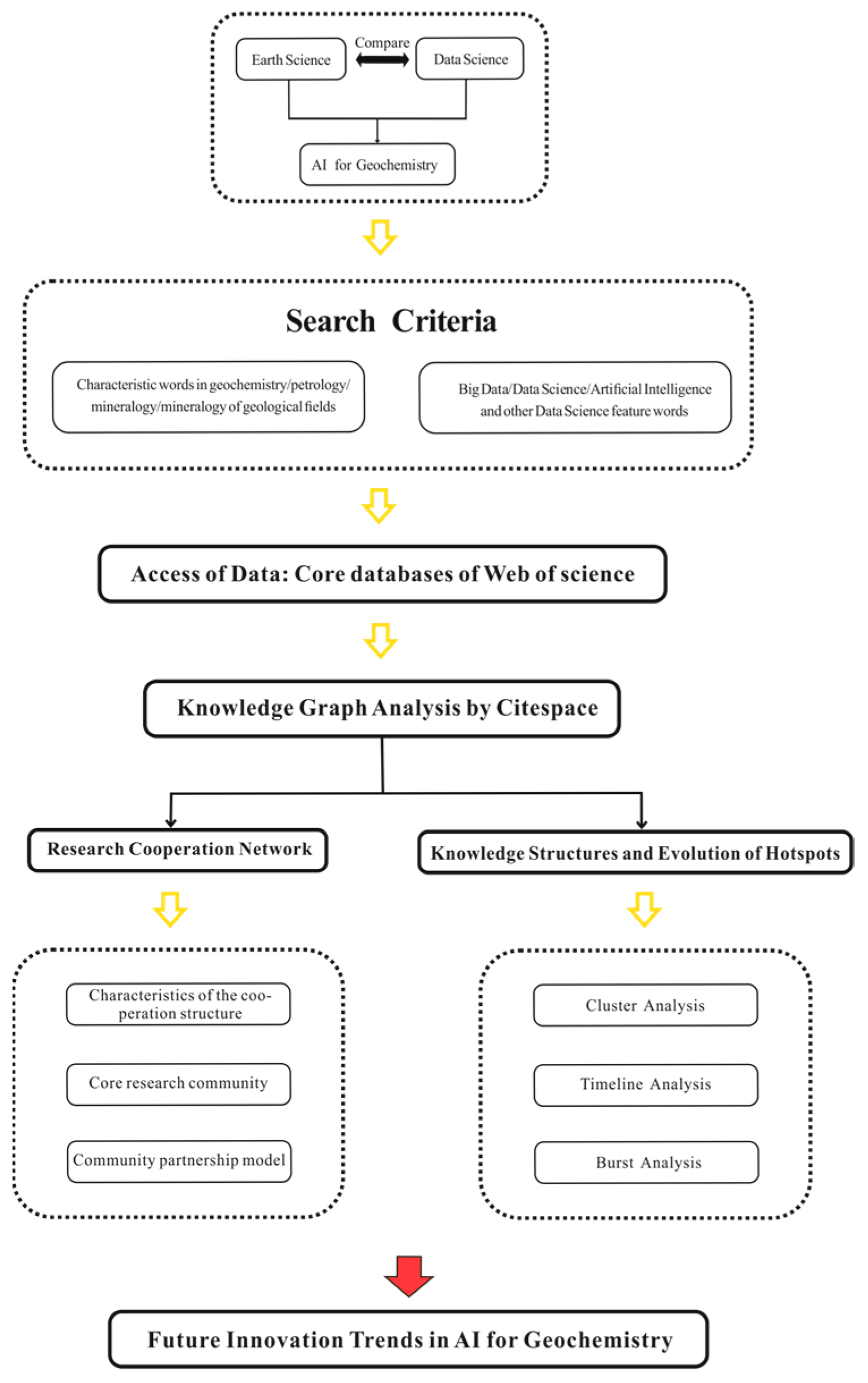

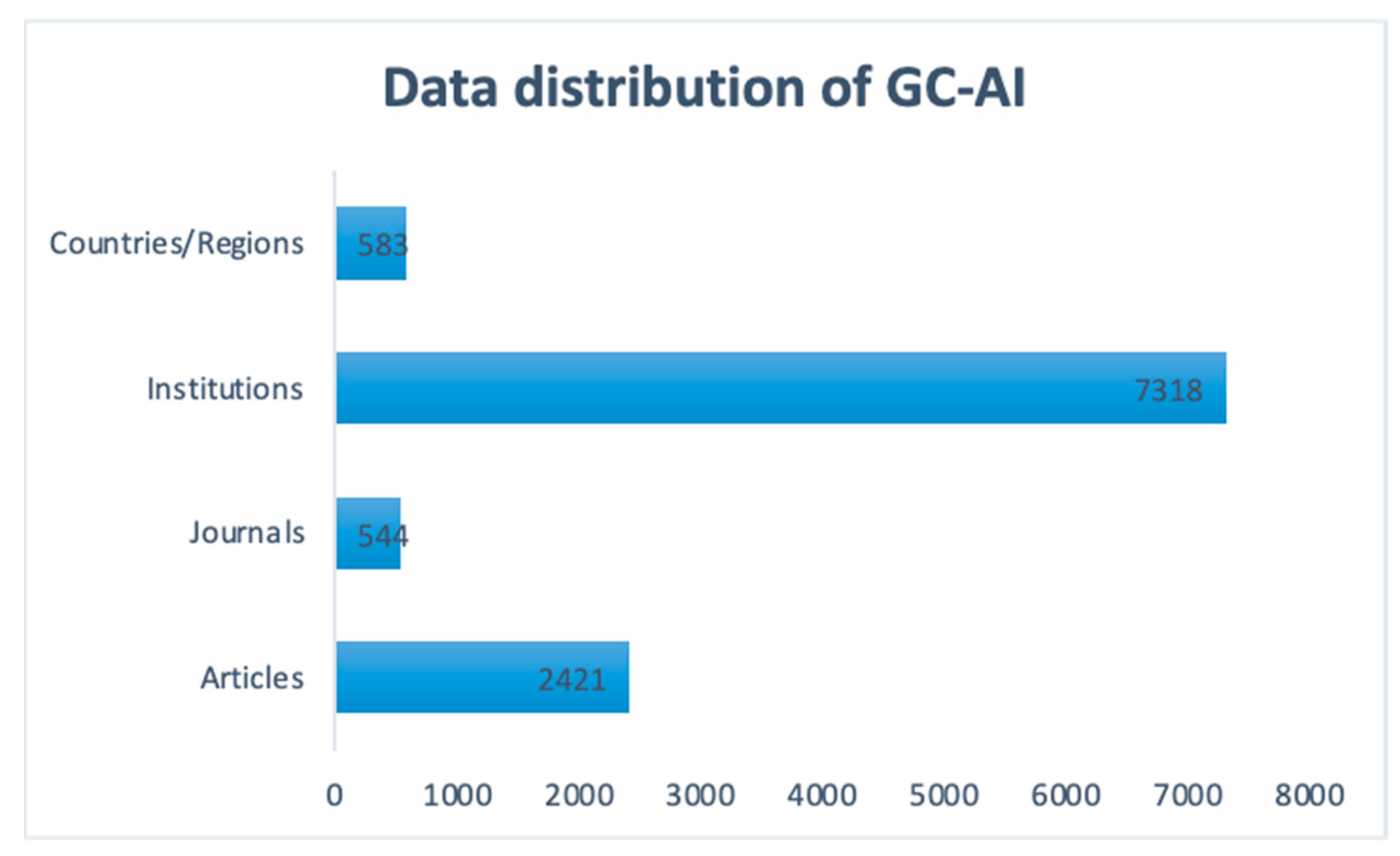
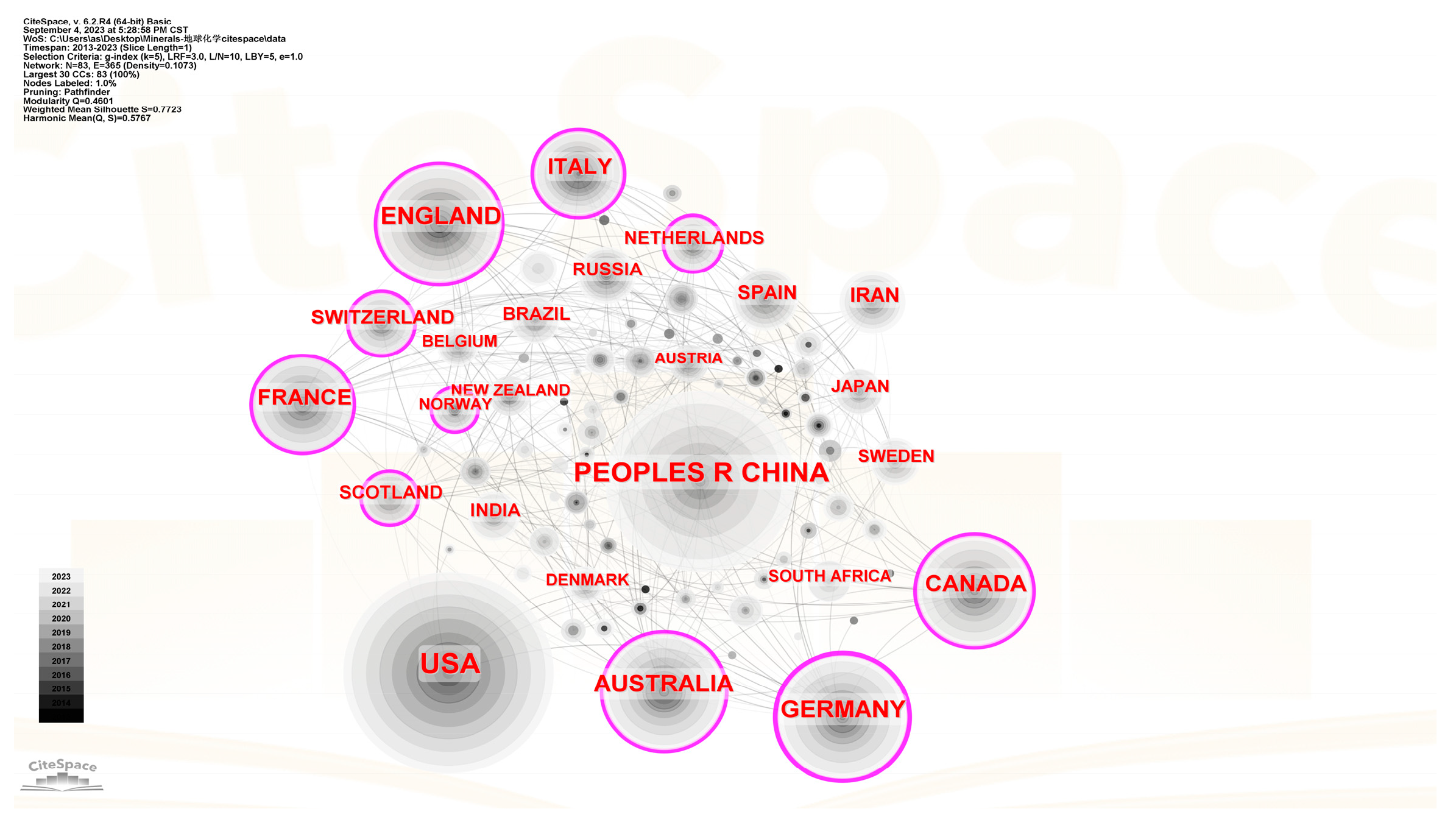
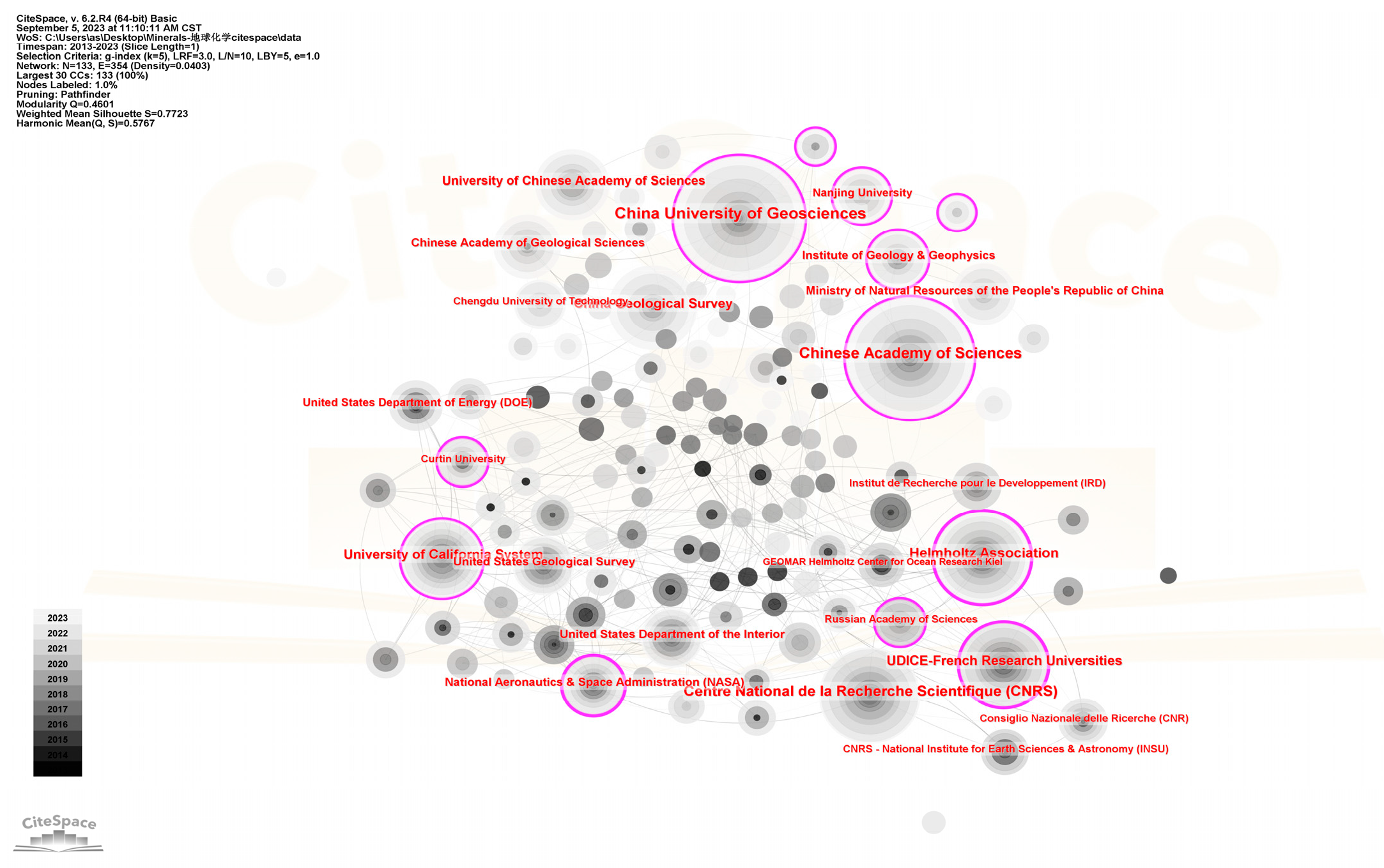
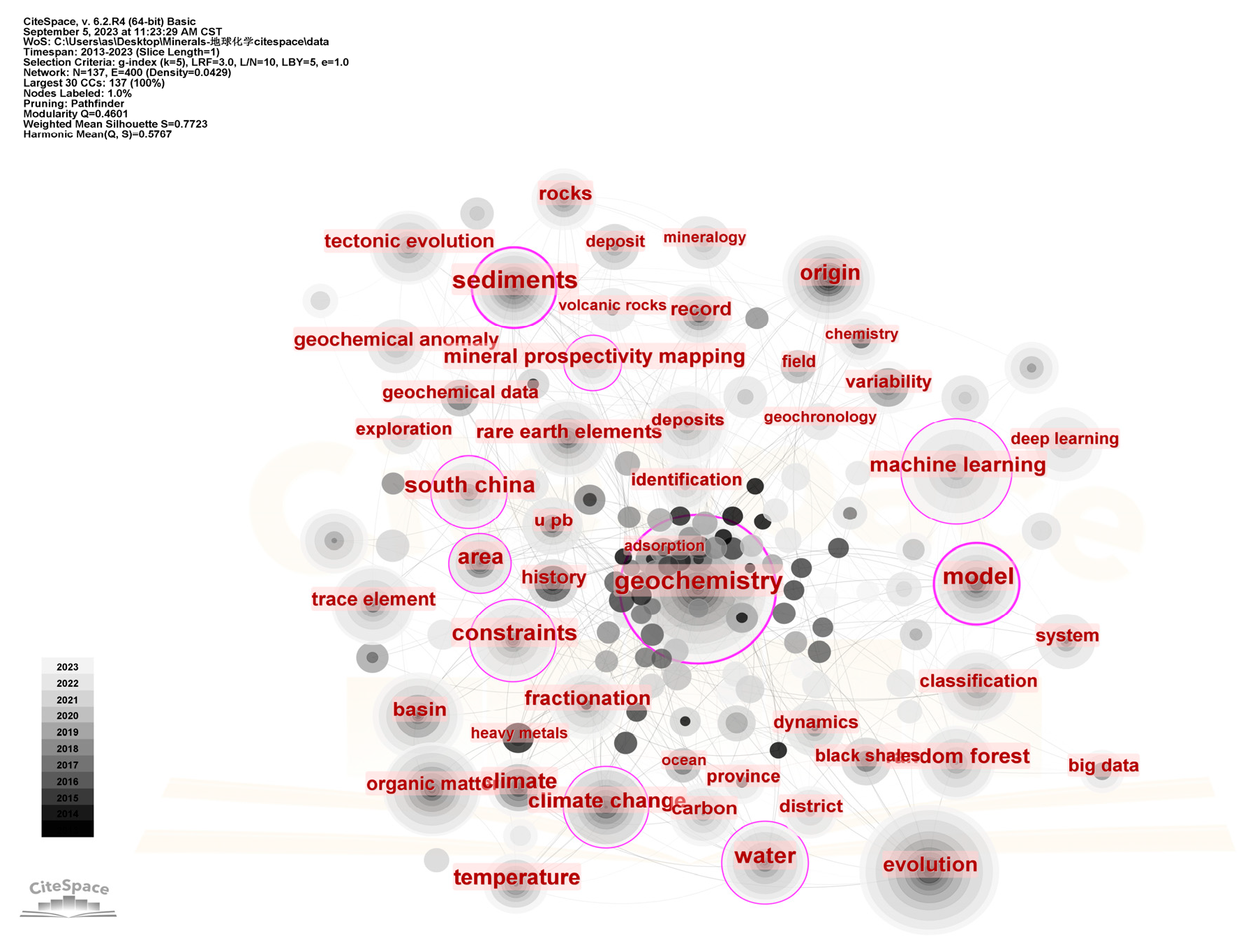
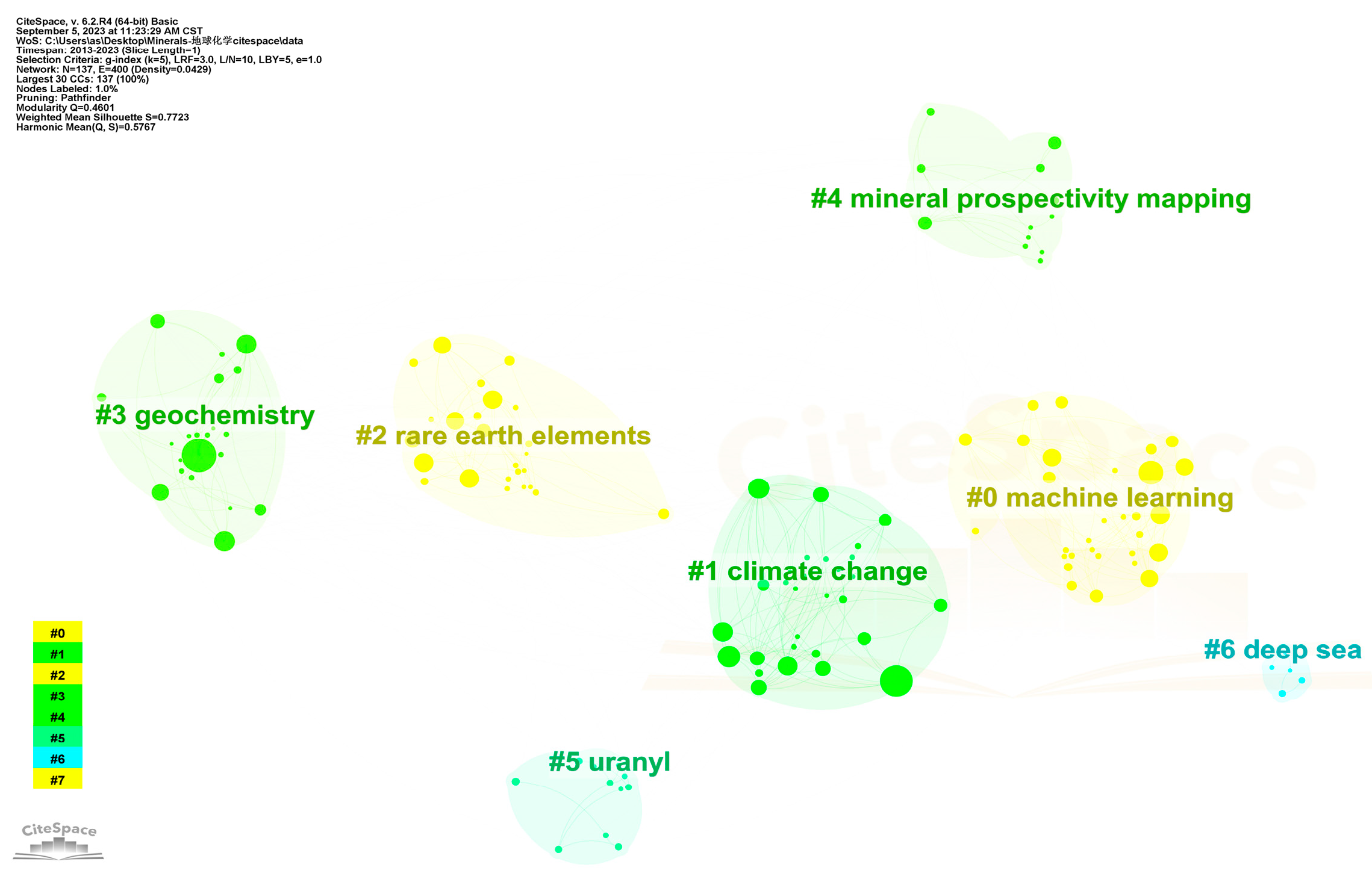
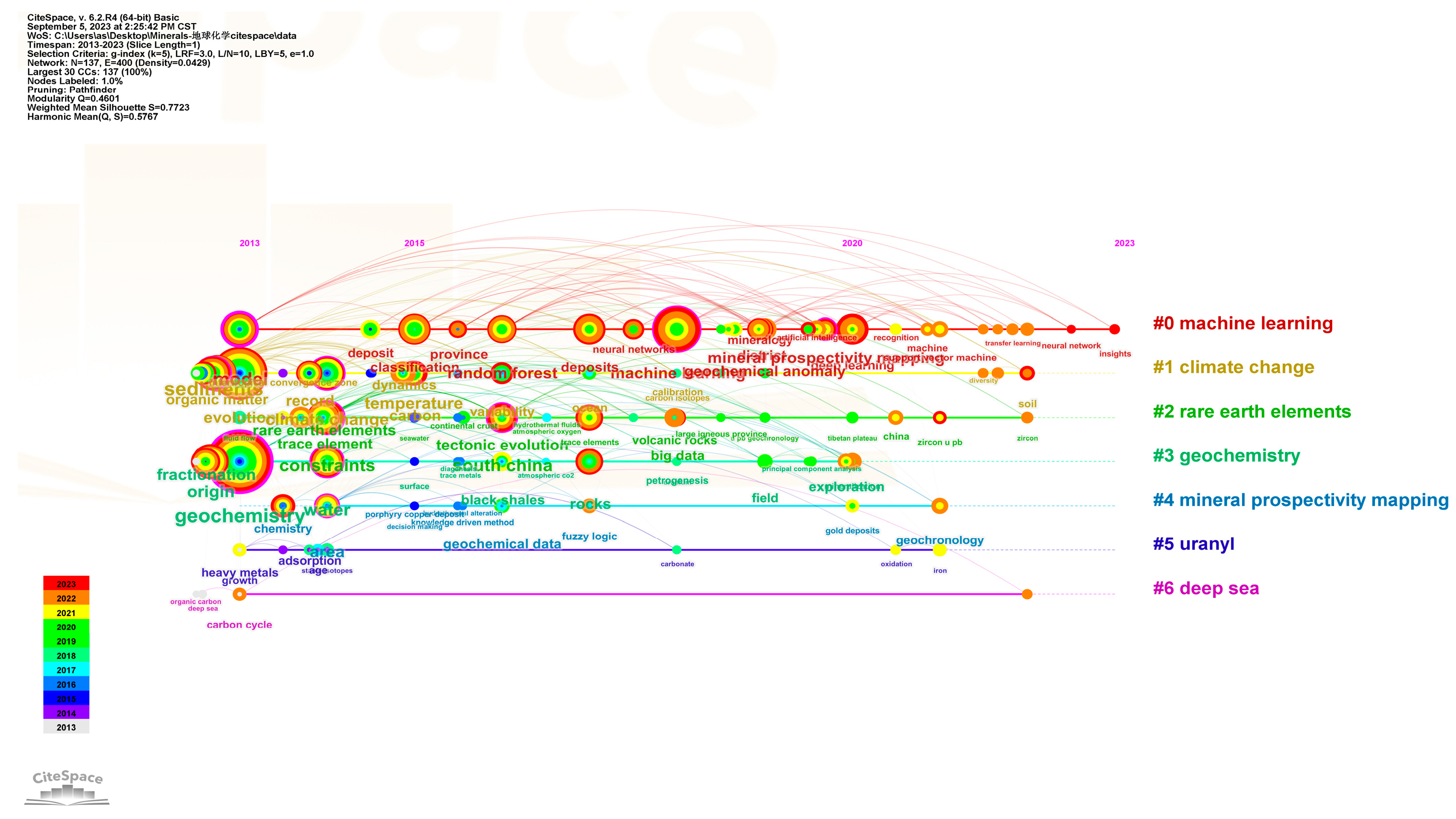
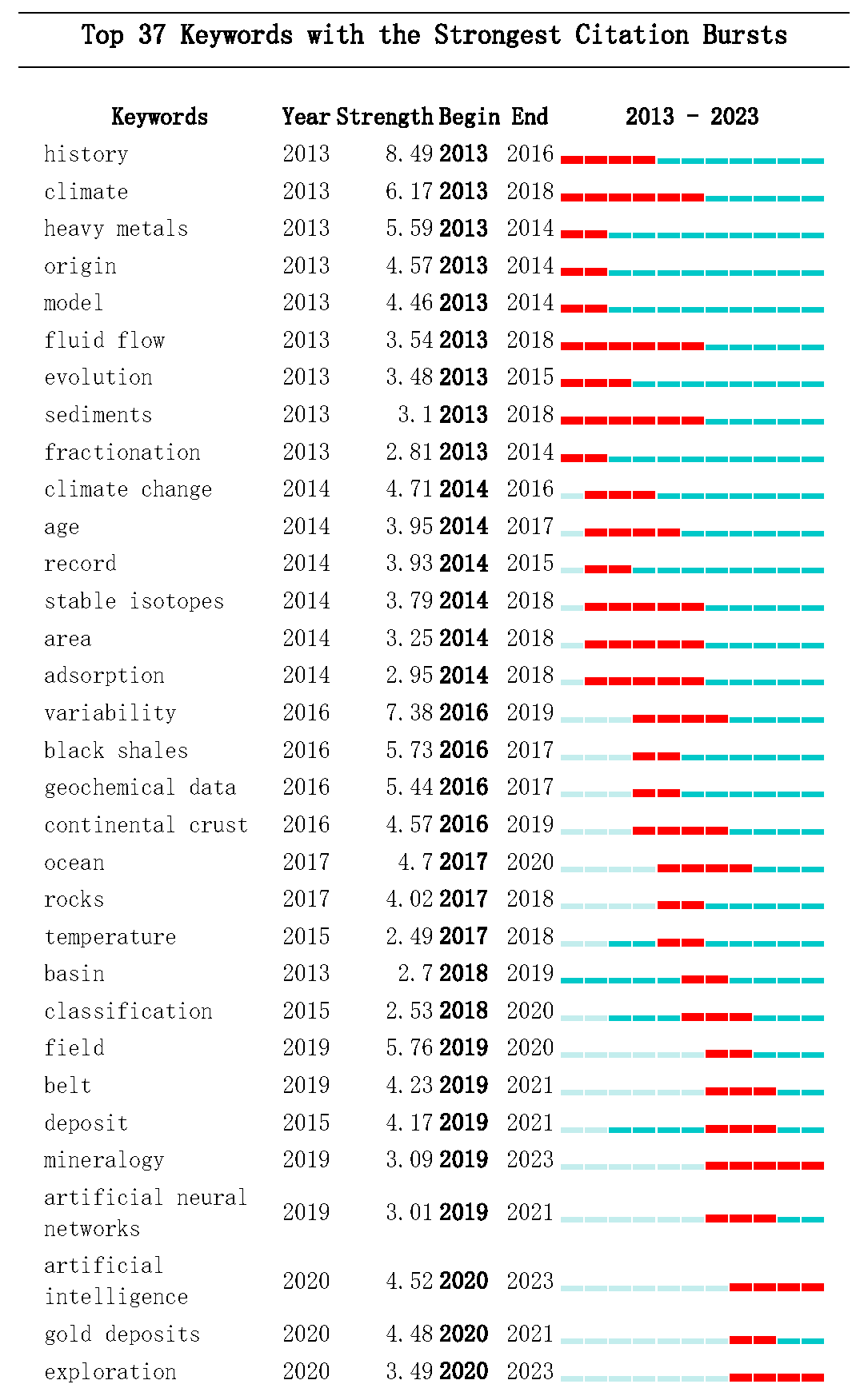
| No. | Counts | Counts/Total | Countries | Centrality |
|---|---|---|---|---|
| 1 | 729 | 30.1% | USA | 0.1 |
| 2 | 620 | 25.6% | China | 0.02 |
| 3 | 290 | 12.0% | Germany | 0.23 |
| 4 | 270 | 11.2% | England | 0.16 |
| 5 | 254 | 10.5% | Australia | 0.13 |
| 6 | 226 | 9.3% | Canada | 0.15 |
| 7 | 176 | 7.3% | France | 0.12 |
| 8 | 150 | 6.2% | Italy | 0.12 |
| 9 | 92 | 3.8% | Iran | 0.03 |
| 10 | 83 | 3.4% | Spain | 0.07 |
| No. | Count | Institutions | Centrality |
|---|---|---|---|
| 1 | 193 | China University of Geosciences | 0.11 |
| 2 | 185 | Chinese Academy of Sciences | 0.13 |
| 3 | 122 | Centre National de la Recherche Scientifique (CNRS) | 0.07 |
| 4 | 113 | Helmholtz Association | 0.32 |
| 5 | 89 | China Geological Survey | 0.04 |
| 6 | 87 | UDICE French Research Universities | 0.24 |
| 7 | 81 | University of California System | 0.17 |
| 8 | 61 | University of Chinese Academy of Sciences | 0.01 |
| 9 | 53 | United States Department of the Interior | 0.1 |
| 10 | 53 | United States Geological Survey | 0.1 |
| No. | Count | Centrality | Keywords |
|---|---|---|---|
| 1 | 165 | 0.27 | Model |
| 2 | 109 | 0.24 | Geochemistry |
| 3 | 50 | 0.22 | Sediments |
| 4 | 69 | 0.18 | Area |
| 5 | 97 | 0.16 | Water |
| 6 | 90 | 0.15 | South China |
| 7 | 42 | 0.14 | Constraints |
| 8 | 36 | 0.14 | Climate change |
| 9 | 37 | 0.1 | Machine learning |
| 10 | 57 | 0.1 | Mineral prospectivity mapping |
| Clusters | Count | Silhouette |
|---|---|---|
| Machine learning | 62 | 0.8 |
| Climate change | 55 | 0.794 |
| Rare earth elements | 54 | 0.705 |
| Geochemistry | 30 | 0.673 |
| Mineral prospectivity mapping | 29 | 0.883 |
| Uranyl | 20 | 0.864 |
| Deep sea | 14 | 0.909 |
Disclaimer/Publisher’s Note: The statements, opinions and data contained in all publications are solely those of the individual author(s) and contributor(s) and not of MDPI and/or the editor(s). MDPI and/or the editor(s) disclaim responsibility for any injury to people or property resulting from any ideas, methods, instructions or products referred to in the content. |
© 2023 by the authors. Licensee MDPI, Basel, Switzerland. This article is an open access article distributed under the terms and conditions of the Creative Commons Attribution (CC BY) license (https://creativecommons.org/licenses/by/4.0/).
Share and Cite
Zhang, Q.; Zhou, Y.; He, J.; Zhu, B.; Han, F.; Long, S. A Review on Global Cooperation Network in the Interdisciplinary Research of Geochemistry Combined with Artificial Intelligence. Minerals 2023, 13, 1332. https://doi.org/10.3390/min13101332
Zhang Q, Zhou Y, He J, Zhu B, Han F, Long S. A Review on Global Cooperation Network in the Interdisciplinary Research of Geochemistry Combined with Artificial Intelligence. Minerals. 2023; 13(10):1332. https://doi.org/10.3390/min13101332
Chicago/Turabian StyleZhang, Qianlong, Yongzhang Zhou, Juxiang He, Biaobiao Zhu, Feng Han, and Shiyao Long. 2023. "A Review on Global Cooperation Network in the Interdisciplinary Research of Geochemistry Combined with Artificial Intelligence" Minerals 13, no. 10: 1332. https://doi.org/10.3390/min13101332
APA StyleZhang, Q., Zhou, Y., He, J., Zhu, B., Han, F., & Long, S. (2023). A Review on Global Cooperation Network in the Interdisciplinary Research of Geochemistry Combined with Artificial Intelligence. Minerals, 13(10), 1332. https://doi.org/10.3390/min13101332







